(MENAFN- ING) Demand for mortgages has fallen to its lowest level since
2007 in Belgium, and while house prices are holding up surprisingly well,
they may paint too rosy a picture of reality. We expect to see prices drop
in the second half of the year, although a major correction seems ruled out for now In this article latest price indicators paint too rosy a picture of the actual house price evolution longer-term borrowing unfolds housing prices holding up for now, but for how long? stability during economic uncertainty
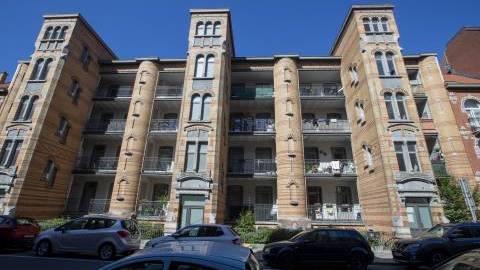
Latest price indicators paint too rosy a picture of the actual house price evolution Demand for mortgage loans in the Belgian real estate market is currently at its lowest level since measurements began in 2007. Only 108,000 mortgage loans were granted in the first half of this year, which is 43% less than the same period last year when the number had already fallen sharply due to rising interest rates. Compared to the first half of 2021, lending was 54% lower.
Fig. 1: Number of mortgage loans granted for a home purchase, the first six months of each year (in thousands)
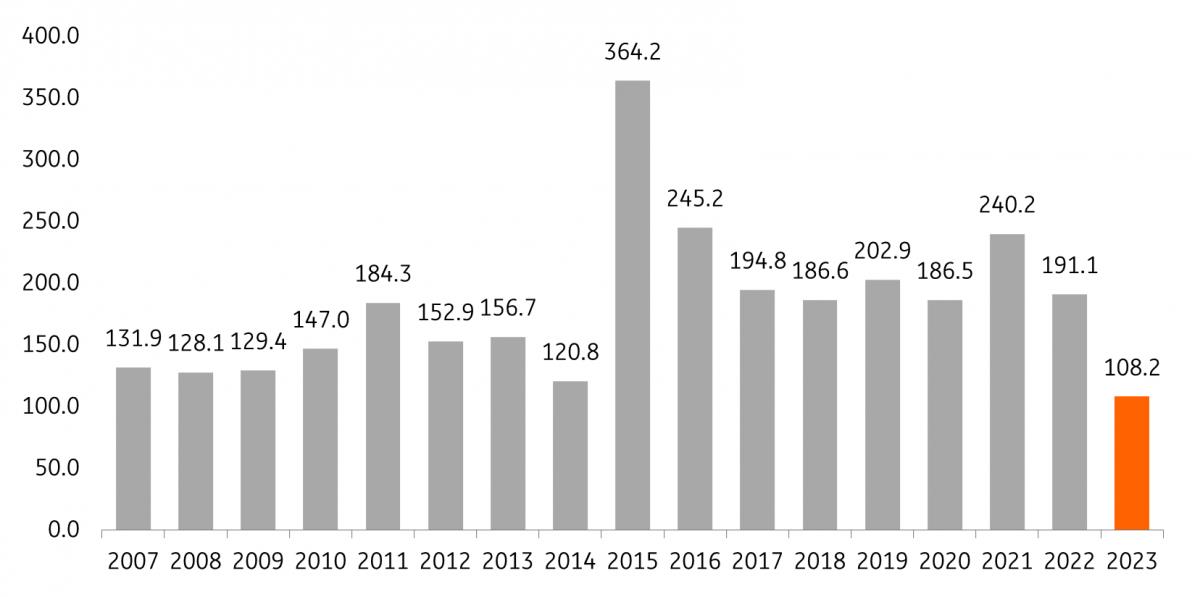
Source: NBB Despite the sharp drop in demand, the impact on prices seems rather limited. The latest price barometers show that house prices are holding up well, with Statbel's property price index rising 1.5% in the first quarter of 2023 compared to the last quarter of 2022. The notary barometer – which contains data on sales contracts up to June – shows that Belgian house prices fell only slightly by 0.3% in the first half of the year compared to the average price last year. This was mainly due to a drop in prices in Wallonia and Brussels. In Flanders, prices are said to have risen further.
Nevertheless, we should be careful when interpreting these price barometers as they may overestimate the true price evolution. The type of homes sold also plays a crucial role. Average prices rise not only when homes become more expensive but also when the characteristics of the homes sold change. For example, if larger and more expensive homes are sold in a given year, this drives up the average price.
Suppose a property market consists of ten homes: two quality homes worth €500,000, six mid-range homes priced at €350,000 and two homes in the cheaper segment priced at €200,000. The average price is 350,000 euro. But if the houses in the lower segment are for sale for longer and only one is sold, for example, the average house price rises to €366,000 – without the prices of the individual houses actually increasing.
We're already beginning to see this effect emerge quite clearly in regions like Flanders. The introduction of the renovation obligation has greatly reduced interest in energy-guzzling houses, which are also generally cheaper. If fewer of these cheaper houses are sold, the average price rises – but that doesn't necessarily mean that all house prices have risen.
Longer-term borrowing unfolds The market was also supported last year by relatively strong wage growth thanks to automatic wage indexation and an extension of the average loan term, which slowed the kink. The average term of new mortgages at ING has risen from 18.9 years in 2021 to 19.8 years in 2022. In the first half of 2023, the average maturity continued to rise further. We're also seeing longer-term borrowing among younger first-time buyers, who are mostly settling on the option of a 25-year term which allows them to borrow more for the same monthly repayment amount.
While a longer maturity usually results in slightly higher interest rates, this increase is generally limited. A longer maturity helps mitigate the impact of higher interest rates, but only partially. Extending the term by one year increases borrowing capacity by about 3% for the same monthly repayment. However, the fixed rate on a 25-year loan has risen from 1.5% to 3.5% since early 2022, reducing borrowing capacity by about 19%. Even if we also factor in wage indexation, this still amounts to an 11% drop in a potential buyer's purchasing power. Higher wages and longer maturities therefore only partially offset the sharp rise in interest rates.
As house prices hold firm and we see no major shifts in the quotient or proportion of income that families spend monthly on loan repayments, we're now seeing buyers bringing in more savings, often from parents and grandparents. Unfortunately, those with less equity are currently being squeezed out of the market.
Housing prices holding up for now, but for how long? We expect a stronger downward trend in house prices in the second half of the year. Historically, falling demand has always translated slowly into lower prices. Homeowners need time to adjust to the new reality – they may remember that their neighbour sold their house for a great price two years ago, and therefore hold on to a higher price initially. As a result, lead times always rise before prices start to fall. We are also seeing more and more evidence that this is the case and that lead times have increased quite significantly. Over time, the probability of owners feeling pressured to accept a lower price and sell begins to rise.
Moreover, interest rates could still increase slightly further. Currently, the fixed rate on a 20-year loan hovers around 3.5%. We could see this rise to 3.6-3.8% in the coming months before stabilising by the end of the year. Buyers could partially offset this with longer-term borrowing, but there is a limit to how long loan maturities can be extended. Finally, the composition effect on prices described above will also diminish. If a higher number of cheaper, energy-hungry homes are sold again in the next six months, this will put additional downward pressure on average prices.
We therefore maintain our forecast of an average decline in house prices of 0.5% this year. This effect is likely to continue as we head into 2024, and we've revised our price forecast for next year downwards from 1% to 0%. Despite the relatively positive picture painted by the latest price barometers, we remain quite cautiin our price expectations.
Fig. 2: House price evolution, including ING forecasts (real prices are nominal prices adjusted for expected inflation)
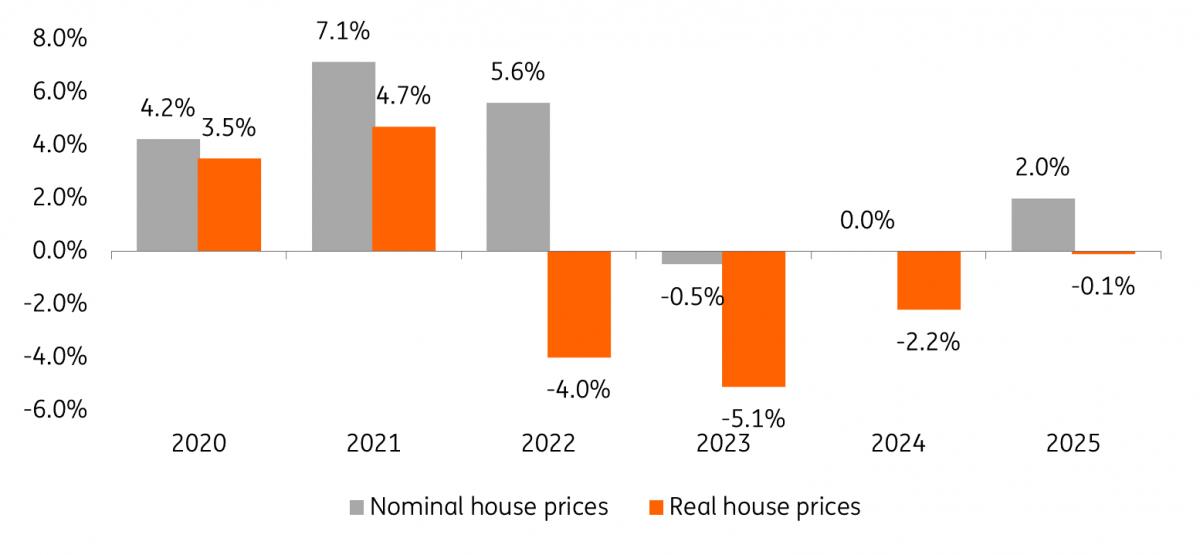
Source: Statbel, ING Stability during economic uncertainty In any case, it's likely that we'll see Belgian house prices fluctuate far more than those in other countries. According to Eurostat figures (which include data up to the first quarter of 2023), prices of existing owner-occupied houses in Germany, the Netherlands and France fell by 9.9%, 3.9% and 1.7% respectively from their peak levels. More recent price indicators suggest that prices fell further in the second quarter.
During periods of economic uncertainty, the Belgian property market often outperforms other countries within the Organisation for Economic Cooperation and Development (OECD). An analysis of house prices in several countries since 1990 reveals Belgium as one of the most stable property markets in the OECD. The standard deviation of house prices during this period is remarkably lower than that of other countries, indicating that Belgian house prices are generally less prone to extreme fluctuations. Moreover, Belgian house prices have fallen in only two years since 1990 – significantly lower than in other countries. By contrast in Germany, France and the Netherlands, house prices fell in 7, 11 and 5 different years respectively over the same period.
Fig. 3: Standard deviation of housing prices, since 1990
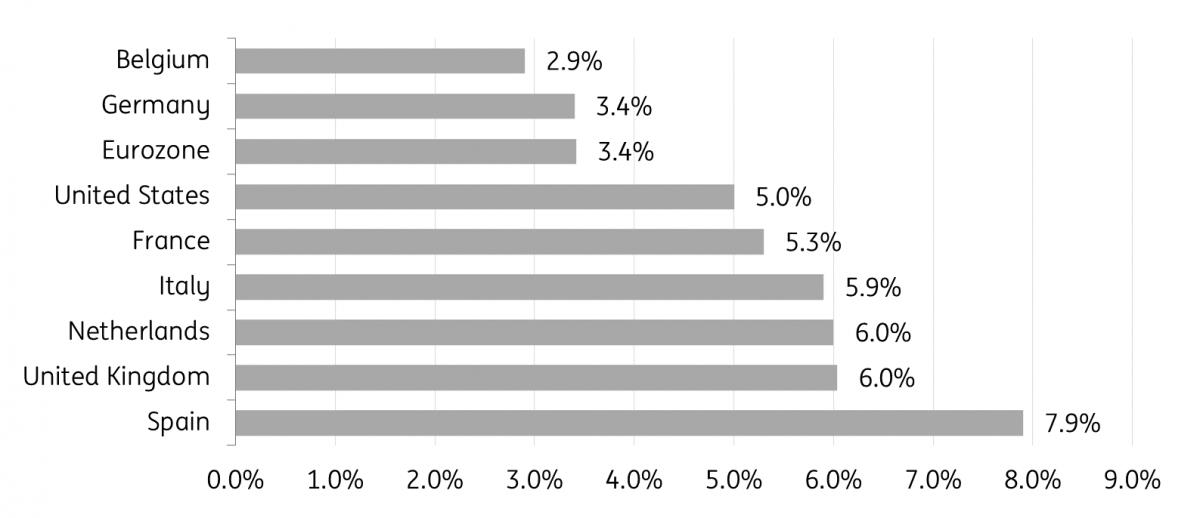
Source: OECD, ING calculations Another striking observation is that even when declines in house prices occur, these corrections aren't quite as sharp in Belgium as elsewhere. Belgium's largest one-year correction since 1990 was a relatively modest 0.6% fall in 2014, according to OECD figures. By comparison, in Spain, house prices fell by 14.8% in one year in 2012, and in theby 8.2% in 2008. The price falls in these countries also occurred when similar patterns were seen for several consecutive years. By contrast, the Belgian property market has shown clear signs of a higher level of stability during periods of economic uncertainty than in other countries.
Fig. 4: Largest annual price drop, since 1990
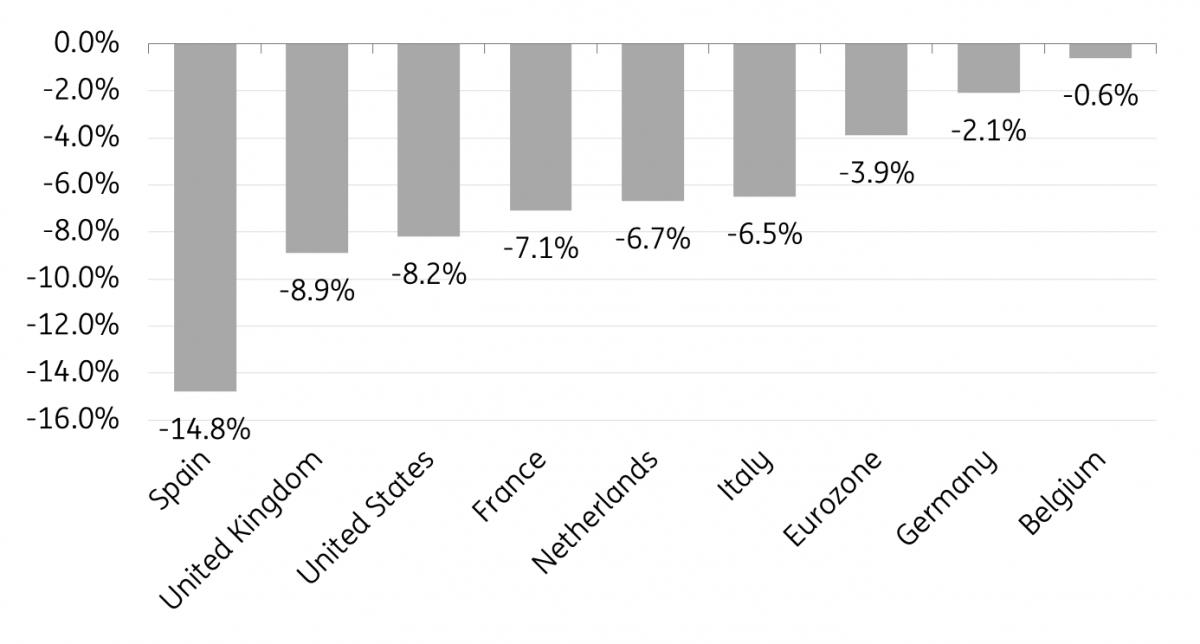
Source: OECD, ING calculations There are several factors that explain the stability of the Belgian real estate market. First, Belgian banks tend to be somewhat more conservative in granting credit for the purchase of real estate due to the financial regulator's macro-prudential regulatory framework. This inhibits speculation and prevents households from being unable to repay their loans due to over-indebtedness, which benefits market stability. Belgian prices also rise less rapidly during boom periods, reducing the risk of overheating the market.
Finally, Belgians place a high value on owning their own home. This tempers price fluctuations, as prospective buyers aren't as likely to abandon their search for fear of falling prices. Despite higher interest rates and stricter regulations, it seems as though most Belgians still see real estate as a safe and sound investment.
A recent ING survey conducted by Ipsos on a representative sample of 1,000 Belgians at the end of June 2023 shows that most are still very confident that prices will continue to rise in the coming year. 60% of respondents expect a price rise of between 0 and 2.5% in the coming year, 20% believe prices will rise more sharply, and the remaining 20% think prices will fall. Remarkably, 51% of respondents do not believe that house prices will ever drop – and this firm belief that house prices will continue to rise is an important stabilising factor.
These figures are striking. 67% of respondents in the same survey believe that the property market is currently overvalued (17% think valuations are correct, 4% think prices are too low and 12% stated no opinion). Most Belgians are also pessimistic about the future affordability of real estate, with 71% expecting that it'll become more difficult for young people to fulfil their housing dreams in the next three years.
For now, we remain cautiin our outlook for the Belgian property market and expect to see a slight decline of 0.5% this year and stagnation next year. The composition effect exerting upward pressure on average prices will gradually soften. Wage growth will also slow down this year, while we expect interest rates to rise slightly further. Weak credit demand and longer turnaround times already point to a further cooling in the second half of the year. However, given that we've experienced few major price shocks in Belgium historically, we shouldn't expect major swings either.